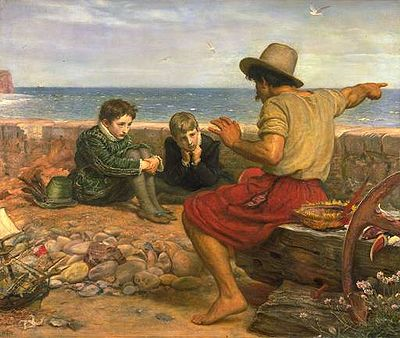
The recent downturns in the economy have fostered a mind numbing litany of accusations, pontifications and shear wonderment. The airwaves are filled with the rattle & hum of fear as the American and now global dream of the future takes daily hits. So much at stake and so little reliable declarations made at a time when everyone is waiting for prophecy. Someone please tell us how to get out of this mess, through this calamity with some semblance of life as we thought we knew it. Spoken, written or sung, painted with the tongue or brush, someone please step forward and tell us who we are.
Barak Obama enters the national and international scene during a period unprecedented in my life time. Even his detractors are secretly hoping he knows how to turn this titanic around or at least plug the hole in the ship and allow us to limp into port. It is evident that the man has significant gifts and he very well may prove to be one of the better leaders our nation has ever known. However, in the meantime, the story of life will not be silenced and epic tales are awaiting the poets pondering. As the nation broods over the next step regarding the economy, harsh sacrificial measures are being offered as the only way forward. We are an age who has emptied our coffers just before a drought. We have leveraged the seed intended for next year’s crop and are now looking for someone or something to sacrifice at the altar of our presumption. Yearend bonuses and record breaking profits of companies like Exxon remind us that in the midst of all the downward spiral something unjust and unsettling remains. More than ever, we long for the resolve of a more powerful explanation. All the cacophony can unfortunately make life seem as if it is about nothing. Just a series of unrelated, unconnected voices all calling out for a hearing but at the moment sounding like noise. Who helps draw these disparate sounds, symbols and images together? Who brings nobility to the suffering, justice to the pitiable, healing to the ailing, and a home to the vagabond? Are there parts of the human condition that can only be awakened through the balm of creatives willing to listen?
In many ways there is a violent struggle right now for power over who gets to form the story. From the partisan battles of Republicans and Democrats to the terrorists and peace-niks, many contingencies are lining up at the soap box & bully pulpit of medai that is the media and offering up their reflection on this screen play in the making. Oddly enough, at a time when all are experiencing such great loss, more than ever we need those committed to listening to and for the healing & hopeful stories needed for the naming. “The future may depend on our remembering that everything has in it a dream of itself,” Rachel Naomi Remen once said. Could this be the genius of creativity and the imagination? Out of these dark spaces and places, could a more hopeful mythos emerge? Ironically, it appears the arts have once again been marginalized and silenced. When cash is low, the first things to go on a local & national level are art programs and music programs. These nearly knee jerk cuts and budgetary slashings across the nation regarding the diminishment of art & beauty reflect a deeper malaise of the soul. These responses tell us of our ignorance on how vital aesthetics are in the understanding of our place in this world and the sustenance of our ongoing stories.
As the bailout turned into TARP and TARP into Obama’s new plan, & now the health care debacle, special interests once again line up at the governmental troughs. Many act as if it were business as usual unconvinced there really is a crisis of funds and subsidies. Lobbyists are coming out of the woodwork knowing from past experiences that something this large would certainly allow for millions of dollars to be designated for their causes and interests. Even as we speak, it is clear that a crisis of this magnitude cannot cure the illness of special interests. Unfortunately the sentiment is, “If we get ours, that is enough.”
In so many of the discussions by politicians and media pundits, it has appeared that one group or endowment was certainly unworthy of any assistance or attention. After all, we are in times where people need jobs, companies need capital, and the consumer needs confidence. It was odd as time after time the Endowment of the Arts would be the first or second line item to cut on the list of groups that certainly did not need any funding or help during this kind of crisis. From pro-lifers upset at family planning clinics birth control perks to parks and wildlife groups who stand to lose their assistance, everyone seemed to dismiss the arts as a coterie worth mentioning. Why? Because the art community is an easy weak victim. They have little collective voice in the circus that is politics, religion and media.
History has told us over and over again what happens when the arts are silenced. In the twentieth century, writers like Alexander Solzhenitsyn cried out from the Gulags warning us of a world of horror taking place in the Soviet Republic. Even African American artists in the 50’s & 60’s like Miles David revealed the darkened heart of a nation caught up in racism. When will we learn that the voice of the artist gives pathos to the sorrow? When will we learn that creativity is often unleashed most powerfully during times when the human soul seems defeated and nearly destroyed?
There is a voice that is the arts. From the dance of Twila Tharp to the comedic social commentary of Lennie Bruce to the ecstatic offerings of Paul Klee, we are enriched by the extravagance of beauty in the midst of loss and exile. More than ever, the arts need to be supported and sustained even sacrificially. Whose voice will frame this current age? Will it be the Wall Street tycoon full of himself and his leveraged world? Will it be the politician convinced his occasional nod to the common man makes him a man of the people? Will it be the angry religious zealots from numerous religions hoping this is the apocalypse so there end times story trumps the world?
Who will offer up a gentler naming? Who will supply us with laughter when our tears have been emptied in full? Who will draw us towards the dance floor for one more round of twirls and spins that can only feed our childlike hearts? The artist will. So I am writing letters. I am sounding off. I am angry at the seeming dismissal of the arts as not only expendable but not even worthy of a discussion. Sing out in protest. Dance a silly dance when everyone is telling you to get serious. Paint your face, hum aloud in a library, and finally lay for an hour gazing at nothing but the canopy of splendor that is our sky. It is our sky. Before it gets sold at auction, let’s enjoy the everlasting. This story is not over. Thank you Jesus.
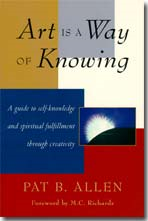
Excerpt from Art Is a Way of Knowing
Knowing the Imagination
Our imagination is the most important faculty we possess. It can be our greatest resource or our most formidable adversary. It is through our imagination that we discern possibilities and options.
Yet imagination is no mere blank slate on which we simply inscribe our will. Rather, imagination is the deepest voice of the soul and can be heard clearly only through cultivation and careful attention. A relationship with our imagination is a relationship with our deepest self: Whether we have cultivated our imagination or not, we each have a lifetime of patterns and habits of thought embedded there, based on past experiences. Our expectations of ourselves and the world flow from these patterns. Suzi Gablik writes: “What we are learning is that for every situation in our lives, there is a thought pattern that both precedes and maintains it. So that our consistent thinking patterns create our experience. By changing our thinking we also change our experience. . . . The basic step is to confront what we actually believe” (p. 27).
Art is a way of knowing what it is we actually believe. Bernie Siegel (1986) is a medical doctor who deeply respects the power of the imagination in regard to physical healing. He asks his cancer patients to draw images of their treatment in order to discover their deeply held beliefs about the treatment options. He has learned that the belief of the patient, not the objective benefit of a particular therapy, is the greatest factor determining effective results.
Knowing what our beliefs are requires confronting ourselves, our fears, and our resistance to change. Once we know what our real beliefs are, we can allow them to evolve and change if they do not serve us. Fear will throw up difficult and unpleasant images at the gate of the imagination. Many of us worry that if we delve too deeply, we may find terrible things, or nothing at all, no options, no solutions. Joanna Macy (1983) works with the imagination to get people to break through apathy about being able to affect the ecology of the planet and other big issues facing all of us. She finds that at first fear and despair arise and even seem overwhelming. Once that despair is felt and acknowledged, however, it passes and new options arise that empower individuals to think of new ways to view the problems and to create new solutions.
Art making is a way to explore our imagination and begin to allow it to be more flexible, to learn how to see more options. The major problem for most of us is that we allow fear to stop the imagination before it really begins to work. Shaun McNiff says that the image never comes to harm us, and I agree. Our fears exist to protect us from what we imagine to be harmful. We need to respect their purpose, to see our fears without allowing them to control the great potential of the imagination.
Before trying to change beliefs through making art, begin by taking an inventory of some beliefs that you hold.
Contents of the imagination. Make a list of your beliefs about imagination. Include any phrases or truisms you have heard, like “It’s only your imagination,” or “You’re letting your imagination run away with you.” Try to articulate the belief behind such statements. Sort your list into statements of belief that are positive and ones that suggest the imagination is dangerous or trivial. Make a check mark by any of the beliefs you are willing to change. See if you can restate them as beliefs you would like to hold.
The wealth of the imagination. Exercising the imagination is a potent form of preparation for making art. Imagining can be done anywhere, anytime. It is a form of play that feeds our inner self: It is a little like stocking the shelves. Later, at another time, art making can bring forth what we’ve imagined and allow the image to take form.
The first step is simply to become aware of the endless stream of images that are available during a day. There are visual images, everything from the rumpled bedclothes, your face in the bathroom mirror, and the steam rising from the shower, to the images of suffering children that flash by on the evening news or the pattern of tree branches against the sky that you see as you walk down the street. There are internal images that can be called up at will, like your sister’s face when she’s laughing, or evoked nonintentionally, as when you remember a special place when you hear a certain song on the radio. Colors, smells, sounds, weather—all of these stimulate imagery to rise within us.
In dreams and daydreams we elaborate images into stories. The imagery of others is also a source; books, movies, poems, are filled with images that we transform by taking them into ourselves. Yet, in order to get through the day, most of the time we screen out images or are only peripherally aware unless something dramatically different comes into view. A spectacular sunset or a car wreck will command our focus on the ride home from work; otherwise we may be lost in thought and oblivious to the images that surround us.
The first step, then, with no outcome in mind, is to begin to practice awareness. Play with the different ways in which you can be aware.
The images are already here. Stop reading for a moment. Sit back in a relaxed posture. Let your eyes fall on the images around you.
Fifteen birds are perched on a wire against a gray November sky outside my window. My desk is crowded with family photos, piles of books, a half-woman, half-deer talisman I made out of sticks, a plastic cow.
Notice the images around you. Appreciate the richness of possibility. Pick one image to follow. Notice its color, shape, texture, detail. Where does it lead you? How did it come to be in front of you? Imagine an art work based on your image. What would it be like? A huge soft sculpture of your stapler? A pencil drawing of the tree outside your window?
Play with your awareness by opening it to include as much as your eyes see. What do you see on the periphery of your vision? Now close your eyes and shift to the pit of your stomach. What is the sensation? What image does it evoke? Open your eyes and go back to your first image. Focus on it; does it seem different? Focus on one detail of that image. Let it go.
Notice what comes up. Sometimes simply shifting our focus to images rather than immersion in our inner dialogue can be a means of achieving relaxation. It is a goalless opportunity for the mind to rest and replenish. At odd moments, practice this skill by choosing to focus on a particular image, then consciously letting it go. It is particularly helpful for relaxation to focus on images of beauty in nature. If your energy is depleted, try focusing on flowers, trees, plants, the sky. Allow yourself to rest in the beauty of what you see, and let that perception replenish your energy. These are very simple means of achieving awareness.
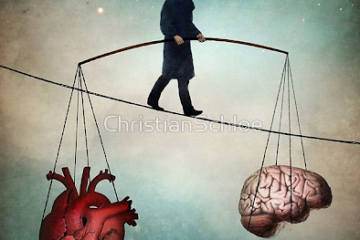
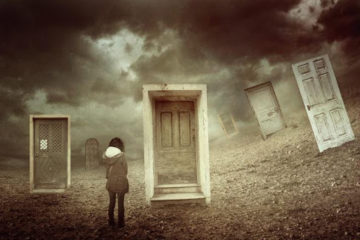
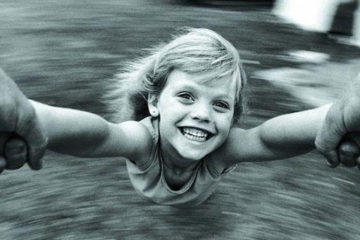
0 Comments